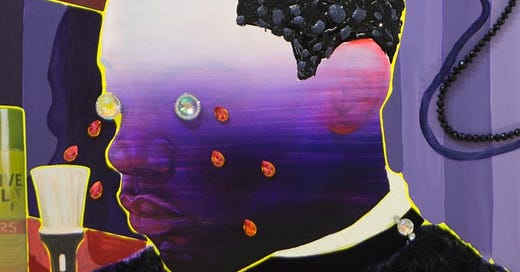Bluff by Danez Smith, Graywolf, 2024
Several weeks ago I attended the Furious Flower Poetry Conference, the once-a-decade, preeminent event toward the celebration / exploration / excavation of Black poetry and poetics. Hosted by the Furious Flower Poetry Center, housed at James Madison University (where I happen to teach), the weekend was an overwhelm of poets, readings, panels, vibe and energy. (To give you a sense of its scope, here is a partial list of poets who read over the course of the conference: Elizabeth Alexander, Rita Dove, Jericho Brown, Camille Dungy, Tyehimba Jess, Lillian-Yvonne Bertram, John Keene, Cornelius Eady, Nikky Finney , Ross Gay, francine j. harris, Roger Reeves, Efe Paul Azino, Danez Smith, Tara Betts, A. B. Spellman, Haryette Mullen, Frank X Walker, Gregory Pardlo, Terrance Hayes, Evie Shockley, Patricia Smith, Kwame Dawes—and that’s just a handful of the weekend’s readers!) It was an incredible event, to say the least—if only it took place more than once every ten years!
A longtime Danez Smith fan, I had recently read his latest collection, Bluff, and was excited to hear him read from it. With a large cast of readers on the bill Smith was quick—he recited the title piece from Don’t Call Us Dead, read one from Bluff then another, the poem “poem,” which includes a rousing call and response invocation, prompting the audience to fill the room with the chant “free Palestine.” There wasn’t much Bluff, but it was hardly a disappointment; Smith is such a performative reader that the few minutes he was onstage were enthralling.
Watching Smith got me thinking about the poems in Bluff that wouldn’t fare as well behind the podium, the more visually oriented pieces scattered throughout the collection: “rondo,” which drives a thick black street straight across the middle of the page, or the slowly accruing striped collage of “the end of guns,” or the quartered page of “sonnet.”
What is the performativity of the visual poem? My recent reading of visually-based text-objects has mostly been through writers such as Mike Carrao, Ava Hoffman, Logan Berry, or pretty much any book from the Inside the Castle catalog, but I think in Smith’s case we encounter something more along the lines of what Douglas Kearney is getting after with his poem-collages. Here is Kearney quoting Evie Shockley (I think—Kearney’s essay (“You Better Hush,” from his book Optic Subwoof) is vague about the source of these words, in the spirit of the words themselves) regarding musical sampling, what he calls an “intertextual and intertextural music”:
Sampling is after more than the phrase, this is something I think people who don’t think much about sampling don’t recognize. That those who are sampling are after text and texture. And often, they are after a multiplicity of textures that will combine to make a single text.
These textures must—and I don’t mean this aesthetically, but technically, by which the aesthetic may follow—have different textures because the sources were recorded using different instruments, with different players, on different mics, in different rooms, using different mixes, made by different engineers, stored on often different media, at often wildly different stylistic eras.
It isn’t just about a bass line. It’s about all of those differences juxtaposed with other differences and how they hold together or fall apart. It’s timbre.
So, it’s about texture.
This certainly feels true of Smith’s poem “the end of guns,” which piles slivered fragments of two indiscernible images in angled rows across the page, accruing, subtracting, floating above the poem’s text which slides low across page like a photo’s caption, the collage almost an ellipses, the text almost an ellipses, the poem unable to evacuate from the horror of its subject matter, accruing, subtracting, slapping a statement on itself in the form of a newspaper clipping, a cutting, making a cut, slapping a cut on top of cuts already made, the slashes present on the page as in the psyche, what are those pictures cut to ribbons, is it possible to not know, let us imagine they are not children in body bags, let us imagine the picture of the clipping slapped atop the dead is not their voice, but it is, but it can’t be, but it must be . . .
The poem reads like a musical score, picture and word on different lines but played together, spliced together, sampled into song. Elegy. Eulogy. The page marks time, the image marks time, the poem overshoots its mark, necessarily shoots past itself that it might infect us. “Differences juxtaposed with other differences and how they hold together or fall apart.”
Texture. It’s the modern condition.




